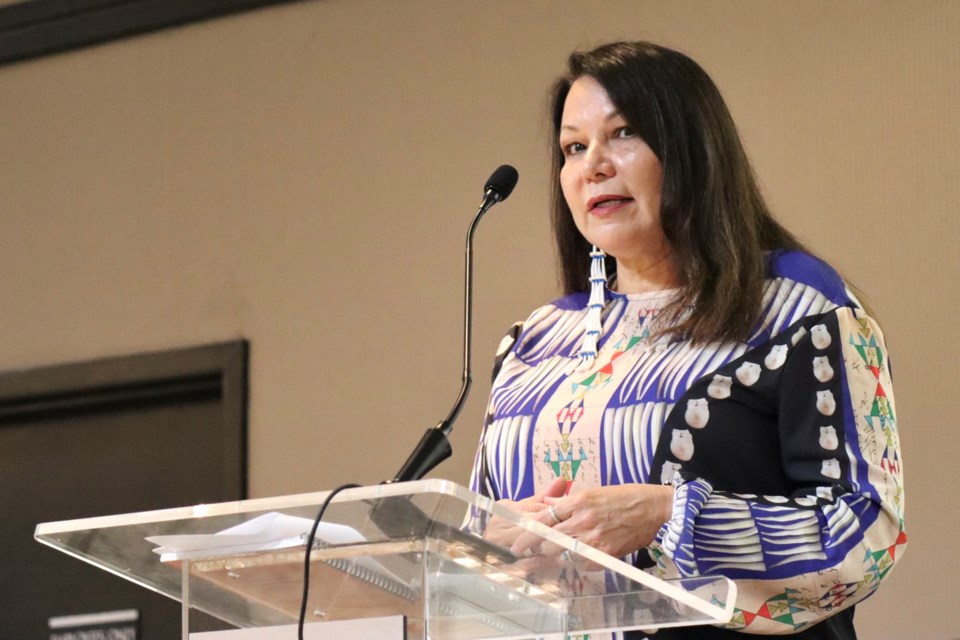There’s $22 billion worth of opportunity available for Indigenous businesses across Canada.
That’s the estimated amount of revenue to be generated from a new National Indigenous Procurement Policy, which is now in effect within Canada’s federal government, noted Dawn Madahbee-Leach, the general manager at Waubetek Business Development Corp.
Under the policy, federal departments and agencies are required to award a minimum of five per cent of their procurement contracts to Indigenous businesses.
It’s a stunning number, but Madahbee-Leach believes the actual benefits to Indigenous companies could well surpass that.
“We’re not restricted to just five per cent,” she said, speaking at the Economic Development Opportunities Forum, hosted by the Anishinabek Nation in Bawating (Sault Ste. Marie) October 24-26. “If we can build those businesses, we can go beyond that.”
This year, Indigenous economic organizations from across the country also collaborated on a business plan for the proposed National Indigenous Procurement Institute, which will manage a certified business directory of Indigenous businesses, using a definition of ‘Indigenous business’ that’s developed by Indigenous people.
“So the government will no longer define who an Indigenous business is — we will,” said Madahbee-Leach, a member of the Aundeck Omni Kaning First Nation on Manitoulin Island.
“This will also ensure that those claiming false Indigeneity will no longer benefit from contracts and set-asides meant for our people.
“This will also make it easier for companies, governments, institutions, and our own communities to find an Indigenous business to supply goods and services.”
A well-known leader in Indigenous economic development, Madahbee-Leach is chair of the National Indigenous Economic Development Board, which has led a number of other initiatives this year to advance opportunities for prosperity among Indigenous communities.
Among them is the National Indigenous Economic Strategy for Canada, which aims to achieve socioeconomic parity — the same levels as non-Indigenous people of education, employment, and income — for Indigenous people in Canada.
The strategy is now being used to inform strategy plans of government, corporate Canada, institutions, and Indigenous communities and organizations across the country, Madahbee-Leach said. And the federal government is looking to it to build its own economic reconciliation framework, she added.
Want more business news from the North? Subscribe to our newsletter.
Work is also continuing on the Indigenous Centre of Excellence on Mineral Development, which has been in development for a number of years.
The centre will be a hub for information on best practices related to consultation with Indigenous peoples in advance of mineral exploration and development. Madahbee-Leach said tools and templates have recently been drafted and are under review.
Natural resources extracted from the traditional territories of Indigenous peoples are Canada’s number one export, she noted, coming in with a value of $300 billion annually.
Between 2016 and 2021, that totalled $1.67 trillion, and that number doesn’t include the minerals and fossil fuels processed and used within Canada, Madahbee-Leach said.
She’s hopeful that the National Benefits-Sharing Framework currently under development by the federal government will finally pave the way for First Nations to benefit financially from the resource developments taking place in their traditional territories.
“These resources are extracted from our traditional territories and treaty areas, yet the majority of our communities remain in poverty. This needs to change,” said Madahbee-Leach.
“Our communities need to fully understand the value of their social licence relating to these developments.”
With so many new initiatives on the horizon, Madahbee-Leach said there is potential for a wide range of new developments for Indigenous communities — urban reserves, fisheries, and international export are just some of the projects taking shape across the country.
And the country’s Indigenous economic developers can help empower people and communities to reach their full potential so they can prosper for generations to come, she added.
“Remember that economic development doesn’t mean forsaking our culture; it means strengthening our ability to protect our culture by having the financial means to support language programs, our language schools, our land-based learning,” she said.
“As economic and business leaders, you are the architects of change. You’re crafting economic strategies that will reflect the uniqueness of your communities.
"Whether it’s sustainable resource development, tourism, or innovative business ventures, you have the collective wisdom and insight to guide your people towards prosperity.”




